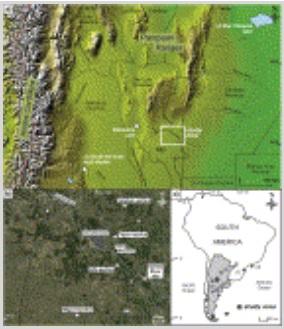Alfonsina Tripaldi, Steven L. Forman, Patricia Ciccioli
2 014
Palaeogeography, Palaeoclimatology and Palaeoecology 411: 122–135, doi: 10.1016/j.palaeo.2014.05.038
Eolian deposits are common in the western Pampas of Argentina, and most are assumed to be associated with glacial conditions. Stratigraphic and sedimentologic studies coupled with OSL dating in San Luis Province document for the first time a nearly continuous sequence of eolian sand sheet deposits that span most of the Holocene. Petrology and geochemical analyses indicate that the source of the sand is from pre-existing Pleistocene eolian sediments. Sandsheet deposition between ca. 12 and 1 ka is associated with sparse, Monte-type vegetation that occurs with drier conditions (MAP 450-100 mm) than the late 20st century (~700 mm). This paleoenvironmental inference is consistent with nearby pollen and lake level records. A persistent semi-arid environment in western Argentina during the Holocene may reflect sustained warm SSTs in the western equatorial Atlantic Ocean, which may have suppressed the pressure gradient between the South Atlantic Anticyclone and Chaco Low and thus, the flux of summer moisture to western Argentina. There appears to be a paleoclimatic “dipole” response between a dry western Argentina and wet southeastern Brazil, which is consistent with increasing strength of the South American Monsoon through the Holocene. Sand sheet accretion appears to cease by 800 to 200 years ago with wetter conditions and succession to Espinal vegetation prior to European contact.

